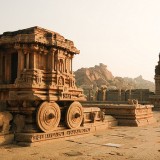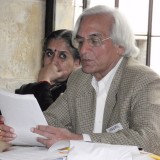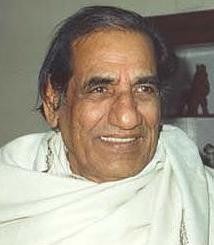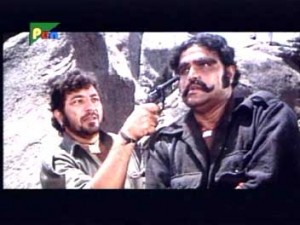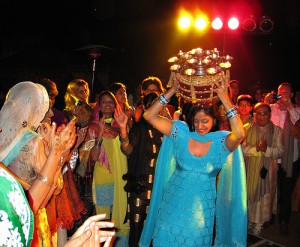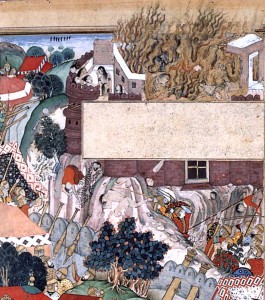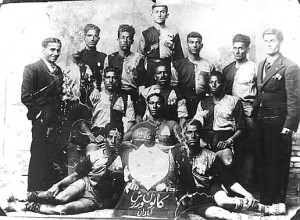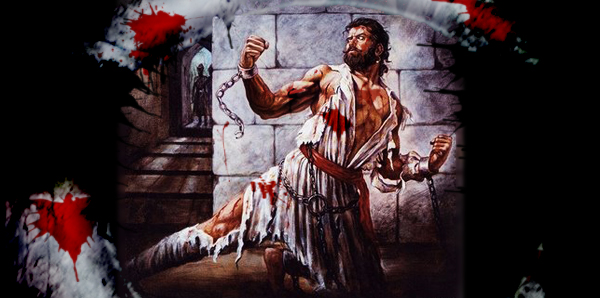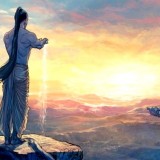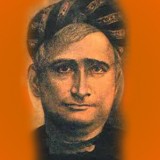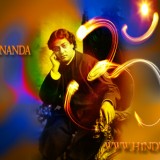[box_light]In classical Indian thought, Yoga in the general sense refers to a particular way of spiritual practice and as such has been taken up by most of the spiritual traditions in India, Hindu, Buddhist and Jain . In this regard, Yoga suggests to us characteristic practices of asana, mantra, pranayama and meditation.[/box_light]
Yoga in this broader sense as spiritual practice has five basic types.
1) Jnana Yoga, the Yoga of Knowledge, using meditation for Self-realization
2) Bhakti Yoga, the Yoga of Devotion, seeking union with God as the Divine Father or Divine Mother
3) Karma Yoga, the Yoga of Service, emphasizing ritual worship of the Divine and service to living beings
4) Raja Yoga, the Royal Yoga of higher techniques and methods, mainly of mantra and meditation.
5) Hatha Yoga, the Yoga of Effort or of lower techniques and methods, mainly asana and pranayama.
All schools of Indian spiritual thought, orthodox and unorthodox, employ one or more of these approaches of Yoga, which they may define in different ways or use relative to different philosophical backgrounds. Many groups employ an integral approach using aspects of all five of these.
Yogic methods can be found in all branches of Indian spiritual and religious literature, whether the Vedas, Epics, Puranas, Agamas and Tantras, as well as in many special Yogic texts or Yoga Shastras. The integrative approach of Yoga pervades the culture of India as well, including its literature, drama, music, dance, science, medicine, and even grammar. It is this broader approach to the meaning of Yoga that we find in Vedic teachings going back to the Rigveda, not simply Yoga as asana as in modern parlance.
However, besides this general meaning and not to be confused with it, Yoga in a specific sense refers to one of the six classical schools of Vedic thought, those philosophies that accept the authority of the Vedas. This is the Yoga school or Yoga Darshana, which is also called ‘Samkhya-Yoga’ owing to its connection with the Samkhya school of Vedic thought, with which it is intimately associated. Unfortunately many people, particularly in the West, confuse Yoga as a general term with Yoga as one of the six Vedic schools, which breeds many distortions. They tend to see Yoga Darshana, particularly the Yoga Sutras of Patanjali as the basis of all Yoga, when it is more accurately the main text of one important branch of Yoga, but not the entire field of Yoga. There are Shaivite, Vaishnava and other Yogas as well, which have their own primary Yoga texts and teachings.
Yoga and the Vedas: Vedic Mantra Yoga
 It is difficult to think of the Vedas without thinking about Yoga, as the Vedas promote spiritual knowledge born of meditation, the way to achieve which is the practice of Yoga. Yoga is a term that is first found in the Vedas, where the root for Yoga, ‘yuj’, meaning to unite, yoke or harness is common, not only relative to horses and chariots, but also relative to the mind and senses. Even the yoking of the Vedic chariot (ratha) is symbolic of deeper Yoga practices of controlling the mind.
It is difficult to think of the Vedas without thinking about Yoga, as the Vedas promote spiritual knowledge born of meditation, the way to achieve which is the practice of Yoga. Yoga is a term that is first found in the Vedas, where the root for Yoga, ‘yuj’, meaning to unite, yoke or harness is common, not only relative to horses and chariots, but also relative to the mind and senses. Even the yoking of the Vedic chariot (ratha) is symbolic of deeper Yoga practices of controlling the mind.
Sometimes people today fail to see the yogic nature of the Rigveda because we are approaching Yoga with a recent modern idea of Yoga as mainly asana or physical postures. Asanas do not have a major role either in the Vedas or in classical yogic texts, including the Yoga Sutras, which only devotes two of two hundred sutras to them.
The Vedas do address with Yoga in an obvious but different way. The Vedas as mantras begin with Mantra Yoga. This is not uncharacteristic of Yoga as a whole as even the Yoga Sutras emphasizes Pranava or the Divine Word as a prime principle of Yoga practice, implying importance to Mantra Yoga The Vedas are themselves mantras and reciting them is itself a path of Mantra Yoga.[i] Even later Mantra Yoga continues to use Vedic mantras like Gayatri as well as resting upon the Sanskrit language, the origin of which is in the Vedas.
Yet mantra has an application in action, which is ritual or karma. Vedic Mantra Yoga has its corresponding Karma Yoga. The Vedas outline the original rituals behind the practice of Karma Yoga, which in India today still extensively employs Vedic fire offerings. Mantra is meant to teach Dharma or the laws of life. As such, the Vedas encourage sacrifice, giving and helping others that is the basis of Seva or service, another important aspect of Karma Yoga.
 Ritual can be defined as a way of sacred action in which we use name and form to approach the nameless and the formless. The implements, substances and materials used in the ritual are not employed for their literal or practical value, though there are correlations. The Vedic fire offerings are not done to produce heat or cook food but to carry messages to the higher worlds. The consecrated Vedic fire is not simply a fire. The substances offered into it are not used merely as fuel for the fire. They indicate movements and offers of the heart. Ritual is way of bringing the sacred or Brahman into action. When that ritual action is turned within, it becomes Yoga.
Ritual can be defined as a way of sacred action in which we use name and form to approach the nameless and the formless. The implements, substances and materials used in the ritual are not employed for their literal or practical value, though there are correlations. The Vedic fire offerings are not done to produce heat or cook food but to carry messages to the higher worlds. The consecrated Vedic fire is not simply a fire. The substances offered into it are not used merely as fuel for the fire. They indicate movements and offers of the heart. Ritual is way of bringing the sacred or Brahman into action. When that ritual action is turned within, it becomes Yoga.
Yet this Vedic ritual is not only outward but also inward. The inner sacrifice involves the offering of speech, prana and mind to the deity within the heart. Yoga can be traced to this inner sacrifice (antaryaga) that includes mantra, pranayama and meditation, a point already noted.
Just as the Vedas imply Yoga, so does Yoga imply the Vedas. The science of Yoga arose in a Vedic context and employs a Vedic terminology like the Purusha and the use of OM, the great Vedic mantra. Most of the great Yoga teachers who have come to the West have been steeped in Vedic teachings as well. Many have been Swamis in Vedantic orders.
The term Yoga arises in the Rigveda itself and is first explained in more obvious terms in s early Upanishads like the Svetashvatara and Katha, which are said to be Yoga Shastras or Yoga texts. Many great Vedic Rishis were regarded as great Yogis including Vasishta, the most famous among them. Hiranyagarbha, the reputed founder of the Yoga tradition, is a Rigvedic deity often connected to Savitar, the Vedic Sun god, with Vasishta as his main disciple
Some modern scholars – generally not trained in the inner meaning of the Vedas – have tried to separate Yoga from the Vedas because Yoga as a specific term is not common in the Rigveda. They fail to note that many other synonyms of Yoga practice do occur in the Rigveda, including karma, yajna, mantra, tapas, svadhyaya, and dhyana.[ii] The Vedic rishi or seer is also a Yogi who has higher powers of consciousness, can commune with the deities, and becomes a deity as well.
The Vedic Yoga and Other Yoga Texts and Teachings
 Yoga is a common topic in all Hindu teachings whether the Tantras, Puranas, Mahabharata or Vedas. The Mahabharata, which includes the Bhagavad Gita, has long sections on Yoga. The Upanishads teach the main principles of Vedantic philosophy and Samkhya that the Yoga system uses. The Upanishads deal with the themes of Yoga as Om, mantra, meditation, control of the mind, knowledge of the Purusha, and so on that are of value in Yoga. Many Upanishadic sages like Yajnavalkya (who represents the solar line of Vedic thought) were regarded as great yogis as well. In addition there is a whole set of Yoga Upanishads that arose at a later period.
Yoga is a common topic in all Hindu teachings whether the Tantras, Puranas, Mahabharata or Vedas. The Mahabharata, which includes the Bhagavad Gita, has long sections on Yoga. The Upanishads teach the main principles of Vedantic philosophy and Samkhya that the Yoga system uses. The Upanishads deal with the themes of Yoga as Om, mantra, meditation, control of the mind, knowledge of the Purusha, and so on that are of value in Yoga. Many Upanishadic sages like Yajnavalkya (who represents the solar line of Vedic thought) were regarded as great yogis as well. In addition there is a whole set of Yoga Upanishads that arose at a later period.
The Vedic Yoga is arguably the origin and seed of the other Yogas. The Rigveda with its thousand hymns is one of the longest Yogic texts and reflects the teaching of the greatest number of rishis and Yogis. Many yogic and Vedantic teachings, starting with the Upanishads, look back to Vedic teachings or paraphrase them. Others recast Vedic teachings but in a new language. Yet for others Vedic principles are there, like Agni and Soma, which are common in Tantras that do not explain specifically their Vedic connections.
The Mahabharata, the great epic in which the Bhagavad Gita, occurs has many explanations of Vedic teachings in its Moksha Dharma section, which like the Gita deals with the highest Self-realization. The Gita is filled with allusions to the Vedic Yoga, but largely recast in a later language around the figure of Lord Krishna. Krishna says that he taught the original Yoga to Vivasvan, who in turn taught it to Manu. This specifically identifies Krishna’s Yoga with the Vedic Yoga. Among the seers, Krishna says he is Ushanas, who is the foremost among the Bhrigus.
Shaivite Yoga goes back to Shiva, along with Rudra and the Maruts in the Vedic language. Rudra is said to be the personification of the Vedic sacrifice, as in the famous Rudram chant of the Krishna Yajur Veda. Shaivite Yoga was earlier called the Pashupati Yoga in the Mahabharata, from Shiva as Pashupati or the lord of the wild animals.
Vedic Yoga and the Yoga Sutras
Yamas and Niyamas
 Among the most obvious connections of the Vedic Yoga with classical Yoga can be found in the Yamas and Niyamas, the yogic principles and life-style practices that constitute the first two of the eight limbs of Yoga, and the three aspects of Kriya Yoga. The Vedas are first of all an attempt to embody and teach dharma. Classical Yoga, as a Vedic tradition, rests upon the dharmic foundation of the Yamas and Niyamas, the Yogic principles of right living.
Among the most obvious connections of the Vedic Yoga with classical Yoga can be found in the Yamas and Niyamas, the yogic principles and life-style practices that constitute the first two of the eight limbs of Yoga, and the three aspects of Kriya Yoga. The Vedas are first of all an attempt to embody and teach dharma. Classical Yoga, as a Vedic tradition, rests upon the dharmic foundation of the Yamas and Niyamas, the Yogic principles of right living.
The Yamas and Niyamas of Yoga are nothing new but a summation or essence of Vedic Dharmic principles found throughout older Vedic texts.[iii]The Yamas and Niyamas reflect the Vedic idea that one must have a dharmic foundation in daily life in order to truly approach the spiritual path.
Kriya Yoga of the Yoga Sutras consists of the three principles of Tapas, Svadhyaya and Ishvara Pranidhana, which form the foundation of the Niyamas. Tapas is perhaps the key principle of Vedic practice, relating specifically to Agni, the basis of the Vedic Yoga and is often identified with the Yajna or the Vedic sacrifice. The Rigveda states that it is through Tapas that the universe is created.[iv] Agni gives us the power of tapas, self-discipline, aspiration, will-power, and inner heat. Agni is connected with Tapo Loka or the realm of Tapas, in Puranic thought. Tapas is the first word of the second section of the Yoga Sutras.
 Svadhyaya commonly means study of the Vedas in Vedic texts, including the Upanishads.[v] It does not simply refer to Self-study in a general sense but to the study of those specific Vedic teachings that were part of one’s family background or given by one’s guru. Its fruit in the Yoga Sutras is the vision of the Ishta Devata,[vi] or chosen form of the Divine that one worshipped in traditional India. These were the prime Hindu Gods and Goddesses of Shiva, Vishnu, Brahma, Surya, Ganesha, and the many complimentary forms of the Goddess or Divine Mother.
Svadhyaya commonly means study of the Vedas in Vedic texts, including the Upanishads.[v] It does not simply refer to Self-study in a general sense but to the study of those specific Vedic teachings that were part of one’s family background or given by one’s guru. Its fruit in the Yoga Sutras is the vision of the Ishta Devata,[vi] or chosen form of the Divine that one worshipped in traditional India. These were the prime Hindu Gods and Goddesses of Shiva, Vishnu, Brahma, Surya, Ganesha, and the many complimentary forms of the Goddess or Divine Mother.
Yet perhaps the most obvious connection between Patanjali Yoga with the Vedic Yoga is the emphasis on Ishvara Pranidhana. Ishvara pranidhana involves surrender to the Divine as the supreme inner power, which is reflected in the Vedic Bhakti or Namas Yoga that involves surrender to the deity in the form of the Vedic Ishta Devatas. Ishvara, or the Lord, is a synonym for Indra, the ruler of the Vedic Gods. Ishvara-pranidhana is primarily Indra-pranidhana in Vedic terms.
Relative to Ishvara Pranidhana, Patanjali emphasizes the importance of Pranava, the primary Pranava which is OM.[vii] As the Vedas are the development of Pranava, he is thereby referring to not just the chanting of OM but the study of the entire Vedas. This makes sense as Patanjali was also a famous Sanskrit grammarian. Sanskrit grammar is also said to develop from Pranava or Om. It is one of the Vedangas or limbs of the Vedas.
 The Yamas are common dharmic principles in Vedic texts. Ahimsa or non-violence is a key principle of Yajna or sacrifice, and is commonly extolled in the Bhagavad Gita and Mahabharata. Sacrifice or Yajna does not mean harming other creatures. It means offering everything to God. Even the rare animal sacrifices that were performed in Vedic times, like Native American ritual killing of the buffalo, were mainly for people who depended upon animals for food.
The Yamas are common dharmic principles in Vedic texts. Ahimsa or non-violence is a key principle of Yajna or sacrifice, and is commonly extolled in the Bhagavad Gita and Mahabharata. Sacrifice or Yajna does not mean harming other creatures. It means offering everything to God. Even the rare animal sacrifices that were performed in Vedic times, like Native American ritual killing of the buffalo, were mainly for people who depended upon animals for food.
Satya or truthfulness is one of the main principles of Vedic thought. In the Rigveda, the Vedic Gods are called satya, particularly Indra. The triune principle of Satyam Rtam Brihat, the truth, the right and the vast is a prime Vedic principle.
Brahmacharya is a key Vedic principle meaning dwelling in Brahman, not simply celibacy but the internal consecration of all one’s energies. It is widely extolled in Vedic texts. Saucha is an important Vedic principle of cleanliness, particularly various forms of ritual bathing that were done on a daily basis. The text Yogi Yajnavalkya goes into great detail into various forms of Snana or bathing as a Yogic practice including the Mantra Snana or using mantra to bathe the mind.
Pranayama and the Other Limbs of Yoga
The dominant deities of the Vedas are those of the Pranic sphere like Indra, Vayu and Vata, Rudra, the Ashwins and the Maruts. Indra as the Supreme Deity of the Vedas is first of all the cosmic and supreme Prana. He is the lord of the air and atmosphere. While we find specific pranayama practices taught in Vedic texts, we do see many hints about them, as well as a frequent extoling of the power of Prana and Vayu. The five Pranas are discussed in detail in the Yajur Veda.[viii]
The Vedas also deal with meditation and particularly with Samadhi. The Rigveda itself speaks of various states of bliss, spiritual intoxication or the flow of Soma. These are not simply drug-based inebriations but a poetic rendition of the Vedic experience of Samadhi that was the goal of all the teachings embodied in the Soma hymns.[ix]
Tantric Yoga and Hatha Yoga
 Traditional Tantric Yoga consists of using ritual, mantra, pranayama and meditation, much like the Vedic approach, including recognizing Agni and Soma or the cosmic fire and nectar powers. Agni relates to the Kundalini Shakti and the three lower chakras that are the seat of Agni in Tantric thought. Soma relates to the nectar of immortality or the Moon in the crown chakra and the three higher chakras in general. In this way, Tantric Yoga develops from the Agni-Soma Yoga of the Rigveda, but recasts Agni as the Goddess and Soma as Shiva as its dominant symbolism. The inner Vedic Yoga of Agni and Soma could easily be called Vedic Tantra and supplemented with all the practices of later Tantric Yoga, which may reflect older secret Vedic practices as well. Tantric Yoga rests upon the mysticism of the Sanskrit alphabet whose roots are in the Vedas. It includes the use of many mantras, including a number of Vedic chants like the Gayatri Mantra.
Traditional Tantric Yoga consists of using ritual, mantra, pranayama and meditation, much like the Vedic approach, including recognizing Agni and Soma or the cosmic fire and nectar powers. Agni relates to the Kundalini Shakti and the three lower chakras that are the seat of Agni in Tantric thought. Soma relates to the nectar of immortality or the Moon in the crown chakra and the three higher chakras in general. In this way, Tantric Yoga develops from the Agni-Soma Yoga of the Rigveda, but recasts Agni as the Goddess and Soma as Shiva as its dominant symbolism. The inner Vedic Yoga of Agni and Soma could easily be called Vedic Tantra and supplemented with all the practices of later Tantric Yoga, which may reflect older secret Vedic practices as well. Tantric Yoga rests upon the mysticism of the Sanskrit alphabet whose roots are in the Vedas. It includes the use of many mantras, including a number of Vedic chants like the Gayatri Mantra.
The main different between the Vedic and Tantric Yoga is that the Vedic Yoga rests upon a symbolism of light whereas the Tantric reflects a more anthropomorphic symbolism of male and female energies. This gives Tantra an iconic presentation, whereas the Vedic is naturalistic. But even here there is considerable overlap.
It is actually easy to see the Vedic basis of traditional Hatha Yoga, because Hatha Yoga is first of all a Yoga of the Sun and the Moon, which are Agni and Soma. Hatha Yoga looks at the Sun and the Moon through the solar and lunar nadis or the Ida and the Pingala. It looks at Agni as Kundalini and the digestive fire, and Soma as the crown Chakra.
Primary Practices of the Vedic Yoga
The Vedic Yoga like classical Yoga is a complex and many-sided discipline designed to address the needs of all the different levels and temperaments of human beings. The Vedic Yoga addresses all of life and works with all of nature, like a symphony using many instruments, with many movements, scales, tones and harmonics. Though it has its practical methodology and precise application, the Vedic Yoga cannot be reduced to any simple pattern, formula or method. One could compare it to a great banyan tree, with roots in both the air and on the ground, and many trunks and branches, on which many creatures can live and find nourishment. Its very complexity is daunting as it reflects the teachings of numerous seers over many centuries. Yet we can still access it today, if we learn how to reorient our vision and awareness in the right way.
 Vedic deities represent various yogic approaches, principles and values but in a symbolic or hidden form. This is one reason why later Yogas, philosophies and Vedic sciences could find their inspiration in looking at Vedic mantras in different ways. Yet it also caused some later thinkers to hold that the Vedic teaching lacked depth and spirituality and was only ritualistic in nature. To enter into the Vedic Yoga requires an inward turning of the mind and heart, a turning away from our current civilizational boundaries, and an ability to embrace the language and mentality of an earlier humanity.
Vedic deities represent various yogic approaches, principles and values but in a symbolic or hidden form. This is one reason why later Yogas, philosophies and Vedic sciences could find their inspiration in looking at Vedic mantras in different ways. Yet it also caused some later thinkers to hold that the Vedic teaching lacked depth and spirituality and was only ritualistic in nature. To enter into the Vedic Yoga requires an inward turning of the mind and heart, a turning away from our current civilizational boundaries, and an ability to embrace the language and mentality of an earlier humanity.
However, beyond its seemingly immense intricacy and labyrinthine maze of forces, the Vedic Yoga follows a coherent and structured process that unfolds in each human being in a similar way. Though we are all different at one level, at another level, we are all part of the same species, the same life, and the same consciousness, following the same rhythm of action and expression. In our inmost souls, we are all part of the onrush of an imperious Divine Will to reach the Supreme, which power has its own law and follows its own seasons. Once we understand the basic principles of the Vedic Yoga, we can begin to discern how its apparently discrete elements fit together into an integral and organic whole. That is why in the end, whatever Vedic deity is followed, one merges the deity into light, bliss, oneness and transcendence.
Vedic Deity or Devata Yoga
 The Vedic is a ‘Deity Yoga’ or Devata Yoga, just as is common in Hindu, Buddhist and Native traditions, including Tantric and Puranic approaches. The Vedic Yoga requires that we awaken the deities within our own minds and hearts and learn to work with them in all the forces of the universe. The Rigveda in particular is the Vedic book of the deities or Devatas, revealing their names, natures and functions. It is through these Divine powers that the Vedic Yoga and Vedic Dharma proceeds.
The Vedic is a ‘Deity Yoga’ or Devata Yoga, just as is common in Hindu, Buddhist and Native traditions, including Tantric and Puranic approaches. The Vedic Yoga requires that we awaken the deities within our own minds and hearts and learn to work with them in all the forces of the universe. The Rigveda in particular is the Vedic book of the deities or Devatas, revealing their names, natures and functions. It is through these Divine powers that the Vedic Yoga and Vedic Dharma proceeds.
Mere practice of Vedic mantras or techniques is not enough to constitute a true Vedic Yoga. It is the Vedic deities that are the agents and the instruments of the Vedic Yoga, not we ourselves, our ordinary minds or human personalities. To understand the Vedas, we must understand the meaning the Vedic deities and come to a living experience of their manifold powers.
Each Vedic deity represents an important approach to inner knowledge, energy and delight. It is both a reflection of the Supreme Godhead and a way to its realization. We can experience these Vedic deities like Indra and Agni as vividly as any other Divine form or manifestation. Ultimately, the Vedic Yoga requires that we understand the deities or cosmic powers behind all that we do. This begins with the biological forces behind our body, breath, and senses and extends to the spiritual principles behind the cosmos
Agni, Awakening the Soul’s Search for Divinity through its Many Lives
The first step not only of the Vedic Yoga, but also of most inner development, consists of awakening the soul or the deeper consciousness of immortality within us. Yoga in the inner sense is a process for the soul or our eternal being to unfold. Yoga is not for the profit or entertainment of our transient personality caught in the illusions of this present birth. Yoga’s purpose is to develop the greater potentials of our inner being, of which our outer personality and self-image is but a veil or an impediment. One must first be willing look beyond the ego self, its urges, demands and expectations to even approach Yoga in the classical sense of the term.
 In yogic thought, what could be called the soul or inner being is the individual Self, our internal or core consciousness that persists throughout the karmic cycle of birth and death, the Jivatman of Vedantic thought. The soul has many bodies, many lives and many personalities. Yet behind these outer formations, the soul has an inherent sense and sure awareness of its own immortality, its Divine purpose, and its Divine goal. For Yoga to be an authentic spiritual practice, it must be done by the soul. Yoga done by the ego or by the mind is a Yoga done only in the shadows, in the darkness of ignorance, not in the light of higher awareness. Our practice of Yoga should be a practice of the heart beyond any social, commercial, personal or cultural concerns. Yet this Yoga of the heart is not a Yoga of the physical, emotional or psychological heart. It is a Yoga of our immortal essence as an eternal soul, whose true labor in its many lives is Yoga, the search to realize its divine and cosmic potential.
In yogic thought, what could be called the soul or inner being is the individual Self, our internal or core consciousness that persists throughout the karmic cycle of birth and death, the Jivatman of Vedantic thought. The soul has many bodies, many lives and many personalities. Yet behind these outer formations, the soul has an inherent sense and sure awareness of its own immortality, its Divine purpose, and its Divine goal. For Yoga to be an authentic spiritual practice, it must be done by the soul. Yoga done by the ego or by the mind is a Yoga done only in the shadows, in the darkness of ignorance, not in the light of higher awareness. Our practice of Yoga should be a practice of the heart beyond any social, commercial, personal or cultural concerns. Yet this Yoga of the heart is not a Yoga of the physical, emotional or psychological heart. It is a Yoga of our immortal essence as an eternal soul, whose true labor in its many lives is Yoga, the search to realize its divine and cosmic potential.
Awakening the soul of Yoga requires bringing our inner fire or soul flame forward as the guide and master of our being. It means awakening to our inner guru and linking up with the inner tradition of truth. This usually requires the light of the outer guru, teaching and tradition, in one form or another, to help us. Lighting our inner fire and keeping it burning through our daily lives and throughout all our states of consciousness as waking, dream and deep sleep is the foundation of all deep Yoga and meditation. This ‘Yoga of the Inner Fire’ or Agni Yoga consists of the cultivation of higher awareness through mantra, inquiry and meditation.
For this there is a wonderful Vedic verse that Sri Aurobindo emphasized:
The mantras love him who remains awake. The harmonies come to him who remains awake. To him who remains awake the Soma says, I am yours and have my home in your close friendship.
The fire remains awake, him the mantras love. The fire remains awake, to him the harmonies come. The fire remains awake, to him the Soma says, I am yours and have my home in your friendship.
Rigveda V.44.14-15
At first, this Agni or sense of God-consciousness is but a spark, a flicker or a small flame hidden deep in the subconscious mind, a mere latent potential. The Vedic Yoga rests upon a surrender to that fire, a cultivation of that fire until it can guide us back to the universal light that is its origin and goal. Yoga consists of various offerings of body, speech, senses, mind and heart into that inner fire. The fire in turn grows with each offering, granting us greater illumination, understanding and well-being.
Eventually that small spark becomes a mighty flame that consumes all impurity – and then expands into a great spiritual Sun within us, full of truth and light, with unlimited powers of illumination. The power of Agni, its tapas-shakti, purifies, heats, ripens, transforms and delivers us from the darkness to the light. We cultivate that fire through right intention, consecration, mantra, inquiry and meditation. This inner fire develops through a higher power of the will, attention, concern, higher values, and a deeper search and inquiry in life.
Through this power, our own spiritual striving, all the other Divine powers have a place to manifest within us, and do so in various ways to different degrees.
Developing Indra, the Master Force of Self-realization
Once the flame of the soul is awakened and has come forth to guide our development, manifesting the Gods or Divine powers, we must soon contact and set in motion the master force, the Divine consciousness in order to achieve the ultimate goal.
 The Vedic God Indra represents the cosmic consciousness that descends into the human being as the lightning flash of direct perception that reveals the highest truth. This descent of grace from above links up with the ascending power of our soul fire from below. Indra is the God-consciousness within us that carries the cosmic and supracosmic Divine in seed form. As ascending and descending forces, Agni and Indra complement one another and comprehend the yogic quest.
The Vedic God Indra represents the cosmic consciousness that descends into the human being as the lightning flash of direct perception that reveals the highest truth. This descent of grace from above links up with the ascending power of our soul fire from below. Indra is the God-consciousness within us that carries the cosmic and supracosmic Divine in seed form. As ascending and descending forces, Agni and Indra complement one another and comprehend the yogic quest.
This Indra consciousness enters through the fontanel and takes its seat in our heart along with Agni. Indra manifests through the perceptive power of the higher or great Prana (Maha Prana), the master life-force behind the universe that is ever seeking greater self-expression, self-mastery and self-realization, ever marching forward to the goal of realizing the entire universe within the mind. These two great powers of Indra and Agni, enlightened Prana from above and awakened will-power from within, overcome all obstacles and manifest all the other Gods or truth principles.
The cultivation of the master force consists of pranayama, discriminating insight, and deep meditation. It involves a revolution at the core of our consciousness itself. This means an inner battle between the powers of light and darkness, a movement from the darkness to the light, in which we can no longer accept anything limited or superficial into our being. Indra is the spiritual warrior who causes us to see the supreme.
Though the Indra force begins to manifest at an early phase of the Vedic Yoga, it is only when the Yoga is complete that his full power can be known. Otherwise that Indra energy must face various obstacles and opposition, the various enemies that he must defeat and conquer along the way.
Developing Surya, the Enlightened Mind
There are many Vedic Sun Gods, called Adityas, which mean ‘powers of unbounded energy and forces of primal intelligence’. The Adityas represent the different powers and principles of the illumined mind and heart. Following a solar symbolism, they are usually said to be seven or twelve in number. The Adityas reflect the principles of Dharma and modes of conduct. Each indicates a teaching that is necessary for our higher realization.
Most important of the Adityas are the pair Varuna and Mitra, who much like Soma and Agni – which they are often identified with – represent the overall cosmic duality. Varuna and Mitra are great Lords of Dharma and instill in us Dharmic values, allowing us to lead a Dharmic life.
In terms of sadhana, Varuna, which means the vastness, represents the discrimination between truth and falsehood, the recognition of karma and the necessity for purification. There is something stern about our meeting with Varuna, who effaces the ego into the higher truth. Yet Varuna protects the Soma principle or cosmic waters, which his grace releases once we have purified ourselves.
 Along with Varuna is Mitra, who is the deity of compassion and love, opposite to and complementary to Varuna’s stern judgment. Mitra, which means friend, is the Divine Friend who leads us like a friend and causes us to seek friendship and harmony with all. Mitra connects us to Agni as the principle of light and the inner guide.
Along with Varuna is Mitra, who is the deity of compassion and love, opposite to and complementary to Varuna’s stern judgment. Mitra, which means friend, is the Divine Friend who leads us like a friend and causes us to seek friendship and harmony with all. Mitra connects us to Agni as the principle of light and the inner guide.
Besides these Mitra and Varuna as the third Aditya is Aryaman, the one who holds the power of nobility and refinement (Arya). Aryaman represents law and force in action, the ability to help, mediate and harmonize. Mitra, Varuna and Aryaman govern the three higher luminous heavens (rochanas) beyond the ordinary three realms of earth, Atmosphere and Heaven.
The fourth Aditya is Bhaga, who holds the power of bliss and delight. He is much like a masculine counterpart of the Goddess Lakshmi, granting not only worldly wealth but spiritual abundance and the richness of devotion. Along with Mitra, Varuna and Aryaman, Bhaga forms the four kings or great rulers of Dharma. Bhaga is connected to Savitar, the transformative aspect of solar energy, which represents the ascending Divine will in creation.
Our Agni, the flame of our inner mind as it develops unfolds the truth principles or dharmic powers represented by the Solar Godheads. They show a progressive development and expansion of the light of truth from the flame to the Sun. They complement the master force and insight of Indra, with various powers of knowledge and illumination. The Yoga of the higher mind (Buddhi) includes meditation on the Adityas and awakening their powers within us. Indra is also present behind the Sun Adityas as their ruling force.
Developing Soma: The Ecstasy of Samadhi
Yoga is a methodology of achieving the state of Samadhi, the level of bliss or Ananda, in which the mind is absorbed in God or in the Self that is its origin. Soma is the Vedic deity of Samadhi, in which all the Vedic deities merge. Soma is lauded as the king of the Gods. All Vedic deities drink the Soma, are energized by the Soma, and are themselves manifestations of the Soma power of bliss. This Soma or bliss is the creator of all but also the goal of all.
Agni is enkindled to prepare the Soma. Indra reaches its fullness of power by the Soma or ecstatic essence of delight that he is the main drinker of. It is his drinking of the Soma that energizes Indra and affords him his master power. The Sun as an enlightenment force exists to take us to the higher bliss of Soma. Soma is the food, milk and lifeblood of all the Vedic deities. It is the unfoldment of the inner Soma that makes one into a rishi or a seer and gives great creative powers. The Vedic Yoga reaches its culmination in the free flowing of Soma that is the highest Samadhi. In Samadhi one learns to drink the immortal Soma that is the consciousness of immortality.
Other Vedic Deities
 The many other Vedic deities that we find lauded in the hymns serve mainly supplementary roles, generally relative to the sphere of the main deity that they relate to as Earth, Atmosphere or Heaven, which are the spheres of Agni, Indra and Surya (Aditya).
The many other Vedic deities that we find lauded in the hymns serve mainly supplementary roles, generally relative to the sphere of the main deity that they relate to as Earth, Atmosphere or Heaven, which are the spheres of Agni, Indra and Surya (Aditya).
There are many forms of Surya or the solar force of light and dharma of the world of heaven. We have mentioned several. There is a group of deities the Adityas. There is also Ushas as the Goddess of the Dawn. The solar deities reflect the principles of Dharma or illumined intelligence.
There are many deities of the atmosphere that connect to Indra. These include Rudra and Brihaspati. In addition, there are group deities the Maruts, Rudras and Ashvins. These atmospheric deities reflect Prana and energy.
Agni and Soma do not have so many associated deities but there are some and they have many hymns of their own. With Agni is most commonly the group of deities the Vasus. With Soma are various watery deities and Goddesses.
The Yoga of Light
The Vedic deities are primarily in their natural symbolism forms of light, with four forms being most prominent: Agni or Fire, Soma or Moon (reflected light), Indra or lightning, and Surya or the Sun (illumination). Yet these aspects of light function not only in the outer world but also in the inner world. In the psyche, Agni or Fire is will, Soma or Moon is the reflective aspect of mind and emotion, Indra or lightning is the energetic aspect of the mind as the power of perception, Surya or the Sun is the illuming power of the mind as awareness. There are four related light centers in the subtle body:
| Surya – Sun |
Spiritual Heart |
Awareness |
| Soma – Moon |
Crown chakra |
Reflection |
| Indra – Lightning |
Third Eye |
Perception |
| Agni – Fire |
Root |
Speech |
Through understanding these four energy centers, we can see how the subtle body and its chakra system was well known to the Vedic seers and integral to the Vedic mantras. The Vedic Devatas or Godheads of light reflect the deepest energies of our own consciousness and their integral unfoldment.
[i] Pranava in Yoga Sutras
[ii] However it is true that classical Yoga came from the late Vedic period and does not always reflect its Vedic roots. Yoga also was employed to some degree by non-Vedic schools like Buddhism and Jainism, but these also employed other Vedic factors like using the mantra Om, Vedic like fire rituals and other Vedic deities and mantras.
[iii] This simple observation seems to be lost on scholars who would like to see Jain or Buddhist influences in the Yamas and Niyamas, rather than common Dharmic values for Dharmic traditions. The Yamas and Niyamas are Vedic principles like tapas and svadhyaya, or related to them like Saucha and Santosha. They do not require any extra Vedic origin.
[vii] Yoga Sutras Pranava
[ix] Note author’s Soma in Yoga and Ayurveda
(27012)
 As is all too common in Nehruvian-secularist discourse, Dalrymple’s analysis of the role of Islam in India stands out by its superficiality. Whenever a Hindu temple or a Muslim festival is found to employ personnel belonging to the opposite religion, secular journalists go gaga and report on this victory of syncretism over religious orthodoxy. Secular historians including Dalrymple do likewise about religious cross-pollination in the past.
As is all too common in Nehruvian-secularist discourse, Dalrymple’s analysis of the role of Islam in India stands out by its superficiality. Whenever a Hindu temple or a Muslim festival is found to employ personnel belonging to the opposite religion, secular journalists go gaga and report on this victory of syncretism over religious orthodoxy. Secular historians including Dalrymple do likewise about religious cross-pollination in the past. Did Muslims “contribute” to Indian culture, as Dalrymple claims? Here too, we should distinguish between what Islam enjoins and what people who happen to be Muslims do. Thus, he says that Muslims contributed to Indian music. I am quite illiterate on art history, but I’ll take his word for it. However, if they did, they did it is spite of Islam, and not because of it. Mohammed closed his ears not to hear the music, and orthodox rulers like Aurangzeb and Ayatollah Khomeini issued measures against it. Likewise, the Moghul school of painting shows that human beings are inexorably fond of visual art, but does not disprove that Islam frowns on it.
Did Muslims “contribute” to Indian culture, as Dalrymple claims? Here too, we should distinguish between what Islam enjoins and what people who happen to be Muslims do. Thus, he says that Muslims contributed to Indian music. I am quite illiterate on art history, but I’ll take his word for it. However, if they did, they did it is spite of Islam, and not because of it. Mohammed closed his ears not to hear the music, and orthodox rulers like Aurangzeb and Ayatollah Khomeini issued measures against it. Likewise, the Moghul school of painting shows that human beings are inexorably fond of visual art, but does not disprove that Islam frowns on it.